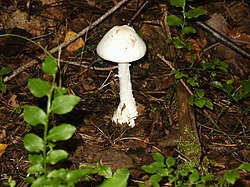Amanita virosa
| Destroying angel | |
|---|---|
 |
|
| Scientific classification | |
| Kingdom: | Fungi |
| Division: | Basidiomycota |
| Class: | Agaricomycetes |
| Subclass: | Hymenomycetes |
| Order: | Agaricales |
| Family: | Amanitaceae |
| Genus: | Amanita |
| Species: | A. virosa |
| Binomial name | |
|
Amanita virosa (Fr.) Bertillon |
|
| Amanita virosa | |
|---|---|
| Mycological characteristics | |
| gills on hymenium | |
|
|
cap is convex or flat |
| hymenium is free | |
| stipe has a ring and volva | |
| spore print is white | |
| ecology is mycorrhizal | |
| edibility: deadly | |
cap is convex
Amanita virosa, commonly known as the European destroying angel, is a deadly poisonous basidiomycete fungus, one of many in the genus Amanita. Occurring in Europe, A. virosa associates with various deciduous and coniferous trees. The large fruiting bodies (i.e., the mushrooms) appear in summer and autumn; the caps, stipes and gills are all white in colour.
Immature specimens of A. virosa resemble several edible species commonly consumed by humans, increasing the risk of accidental poisoning. Small specimens may resemble the common Portobello mushroom to non-experts, but just a piece of an A. virosa in a soup with hundreds of edible mushrooms is poisonous enough to kill all who eat the soup. The symptoms of poisoning comes generally several hours afterwards, a fact which makes this fungus even more problematic. Along with its geographical namesakes, A. virosa is one of the most poisonous of all known poisonous mushrooms; its principal toxic constituent α-amanitin damages the liver and kidneys, usually fatally.
The common name of destroying angel is applied to several all-white species of poisonous Amanita, to this species in Europe and to Amanita bisporigera in eastern North America, and A. ocreata in the west. A. virosa was first collected and described by Elias Magnus Fries in Sweden. Its specific epithet virosa derived from the Latin adjective virōsus 'toxic' (compare virus).
...
Wikipedia
